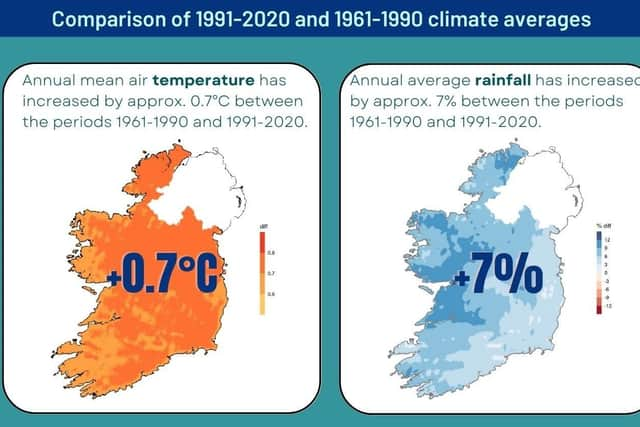Ireland has become warmer and wetter in the last 30 years says Met Éireann
and live on Freeview channel 276
These are the 30-year averages of observed variables such as rainfall and temperature.
The key findings from Met Éireann’s analysis of the 1991-2020 climate averages highlight changes in Ireland’s climate over the past three decades.
Advertisement
Advertisement
The most notable one being an overall increase in air temperature compared to the previous 30-year period with the average yearly air temperature for Ireland standing at 9.8°C (1991-2020). This represents an increase of 0.7°C.


Furthermore, mean temperatures are higher across the country for all seasons in the most recent 30-year period.
The research also shows that sunshine hours have increased by approximately 5% when compared to the 1961-1990 period, with May as the sunniest month of the year followed by June.
Met Éireann’s analysis also reveals an increase in rainfall of approximately 7% over the last 30 years when compared to the 1961-1990 period, with annual average rainfall for Ireland at 1,288 mm (1991-2020). Regional variations are also evident, with the West and North of Ireland showing the greatest increases in annual rainfall.
Advertisement
Advertisement
The release of these findings by Met Éireann comes ahead of the World Meteorological Organisation’s (WMO) publication of the Global Climate Averages (or Climate Normals) for 1991-2020, due to take place this August.


Met Éireann contributes to the development of this global dataset through the provision of data from Ireland’s equivalent 30-year period averages.
Met Éireann Climatologist and Project Lead, Mary Curley, said: “The publication of Ireland’s most recent climate averages allows us to assess how Ireland’s current climate compares to the previous 30-year period. We know that the atmosphere is warming and what we’re seeing at the local and national scale fits the international picture.
“Importantly, the data provides information about typical climate conditions for a particular location and is a crucial benchmark for weather and climate conditions. This serves as an important resource for government and relevant stakeholders to enable informed decision making to benefit society.”
Advertisement
Advertisement
She added: “While these averages give us an up-to-date baseline to compare our current and future weather to, it’s important to remember that weather patterns can vary significantly from year to year.”
The findings in these new 30-year averages align with the results from Met Éireann’s TRANSLATE climate projections, optimised for Ireland, which were released in June. TRANSLATE confirms the likelihood of a warmer and wetter climate annually for Ireland, in relation to future potential global warming under different green-house emission scenarios.
Met Éireann will publish a comprehensive technical report on the 30-year averages 1991-2020 on met.ie later this year, which will provide more detailed information.